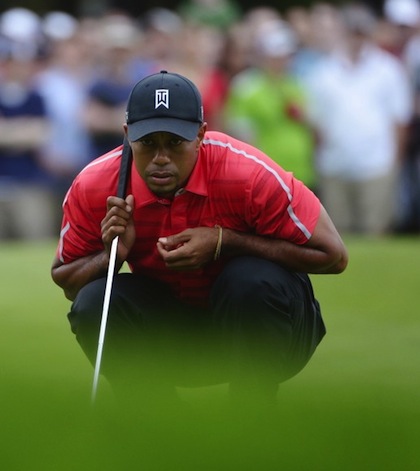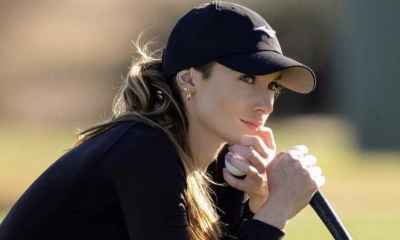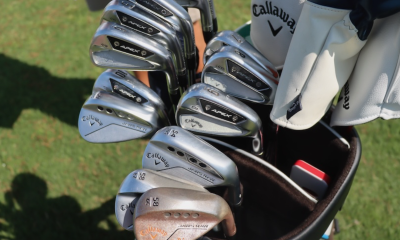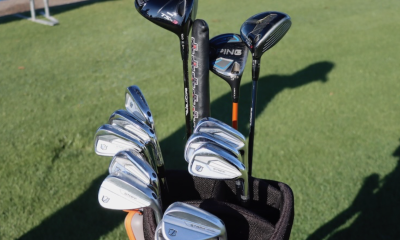Instruction
Use visualization, imagery like many of golf’s greats

The saying “success leaves clues” is as true in golf as it is in all other sports.
Golf’s all-time greats and top athletes from other sports have used similar universal principles to reach their full athletic prowess. There are multiple fundamentals shared by the best of the best.
One of my favorite and most powerful traits shared by top athletes is their ability to use pictures and mental images. This amazing ability to control images is called visualization and imagery by sport psychologists.
Most of the greatest golfers from history have used some form of visualization and mental imagery, including golf’s all time leading major champion Jack Nicklaus.
“I never hit a shot, not even in practice, without having a very sharp, in-focus picture of it in my head,” Nicklaus said. “First, I see the ball where I want it to finish, nice and white and sitting up high on the bright green grass. Then, the scene quickly changes, and I see the ball going there: its path, trajectory, and shape, even its behavior on landing. Then there is a sort of fade-out, and the next scene shows me making the kind of swing that will turn the previous images into reality.”
Nicklaus has even affirmed that 50 percent of success in golf is a golfer’s mental picture. Growing up, Tiger Woods said one of his most important thoughts was where he wanted to ball to go. Meaning, he had a clear picture of the shot he wanted to hit. Similar to Nicklaus and Tiger, greats from other sports like hockey’s all-time leading scorer Wayne Gretzky have admitted to using pictures as a major part of his success.
“We taped a lot of famous pictures on the locker-room doors,” Gretzky says. “Bobby Orr, Felix Potvin, John Beliveau, all holding the Stanley Cup. We’d stand back and look at them and envision ourselves doing it. I really believe if you visualize yourself doing something, you can make that image come true … I must have rehearsed it 10,000 times. And when it came true it was like an eclectic jolt went up my spine.”
Whether you’re aspiring to be a top junior, college player, professional, or weekend warrior, one thing is for sure — visualization and imagery are a critical component to a golfer’s performance and mental game.
This is a major reason why all the students I work with in our junior golf program and our Post Graduate Program at the Gary Gilchrist Golf Academy are trained to use visualization and imagery during our mental coaching sessions.
Visualization isn’t a mental strategy limited to professionals and top junior golfers. Science has demonstrated that mental imagery is beneficial to all golfers, regardless of age or current ability level.
Sport psychology research has found a strong link between performance and the visual pictures golfers use in a new line of exciting research called Functional Equivalence. If this term sounds confusing, don’t worry. The idea behind it is simple. All it means is that the same areas of the brain are activated when imagining a movement as actually making that movement. Meaning, if you were to imagine making a golf swing, many of the same areas within your brain are activated as when actually making the golf swing. In essence, the brain acts the same way when imagining a movement as when actually making the movement.
So why is this important? How can this help you? Simply put, every time you imagine something your brain is mentally practicing to make that image come true. This means that your imagination can act as an amazing tool in developing and training your mental game and golf game.
Since everything you imagine sends a signal to your brain, it means that not only are good images sent to your brain, but so are the negative images.
So be careful of the images and pictures you choose to focus on. You must learn to gain control of your imagination and not let your imagination control you. The golfers who are most happy and achieve the most success in golf have learned to master their imagination and send more positive pictures to their brain then negative ones.
- LIKE9
- LEGIT8
- WOW2
- LOL2
- IDHT1
- FLOP1
- OB2
- SHANK3
Instruction
Clement: Laid-off or perfect fade? Across-the-line or perfect draw?

Some call the image on the left laid off, but if you are hitting a fade, this could be a perfect backswing for it! Same for across the line for a draw! Stop racking your brain with perceived mistakes and simply match backswing to shot shape!
- LIKE0
- LEGIT0
- WOW0
- LOL0
- IDHT0
- FLOP0
- OB0
- SHANK1
Instruction
The Wedge Guy: The easiest-to-learn golf basic

My golf learning began with this simple fact – if you don’t have a fundamentally sound hold on the golf club, it is practically impossible for your body to execute a fundamentally sound golf swing. I’m still a big believer that the golf swing is much easier to execute if you begin with the proper hold on the club.
As you might imagine, I come into contact with hundreds of golfers of all skill levels. And it is very rare to see a good player with a bad hold on the golf club. There are some exceptions, for sure, but they are very few and very far between, and they typically have beat so many balls with their poor grip that they’ve found a way to work around it.
The reality of biophysics is that the body moves only in certain ways – and the particulars of the way you hold the golf club can totally prevent a sound swing motion that allows the club to release properly through the impact zone. The wonderful thing is that anyone can learn how to put a fundamentally sound hold on the golf club, and you can practice it anywhere your hands are not otherwise engaged, like watching TV or just sitting and relaxing.
Whether you prefer an overlap, interlock or full-finger (not baseball!) grip on the club, the same fundamentals apply. Here are the major grip faults I see most often, in the order of the frequency:
Mis-aligned hands
By this I mean that the palms of the two hands are not parallel to each other. Too many golfers have a weak left hand and strong right, or vice versa. The easiest way to learn how to hold the club with your palms aligned properly is to grip a plain wooden ruler or yardstick. It forces the hands to align properly and shows you how that feels. If you grip and re-grip a yardstick several times, then grip a club, you’ll see that the learning curve is almost immediate.
The position of the grip in the upper/left hand
I also observe many golfers who have the butt of the grip too far into the heel pad of the upper hand (the left hand for right-handed players). It’s amazing how much easier it is to release the club through the ball if even 1/4-1/2″ of the butt is beyond the left heel pad. Try this yourself to see what I mean. Swing the club freely with just your left hand and notice the difference in its release from when you hold it at the end of the grip, versus gripping down even a half inch.
To help you really understand how this works, go to the range and hit shots with your five-iron gripped down a full inch to make the club the same length as your seven-iron. You will probably see an amazing shot shape difference, and likely not see as much distance loss as you would expect.
Too much lower (right) hand on the club
It seems like almost all golfers of 8-10 handicap or higher have the club too far into the palm of the lower hand, because that feels “good” if you are trying to control the path of the clubhead to the ball. But the golf swing is not an effort to hit at the ball – it is a swing of the club. The proper hold on the club has the grip underneath the pad at the base of the fingers. This will likely feel “weak” to you — like you cannot control the club like that. EXACTLY. You should not be trying to control the club with your lower/master hand.
Gripping too tightly
Nearly all golfers hold the club too tightly, which tenses up the forearms and prevents a proper release of the club through impact. In order for the club to move back and through properly, you must feel that the club is controlled by the last three fingers of the upper hand, and the middle two fingers of the lower hand. If you engage your thumbs and forefingers in “holding” the club, the result will almost always be a grip that is too tight. Try this for yourself. Hold the club in your upper hand only, and squeeze firmly with just the last three fingers, with the forefinger and thumb off the club entirely. You have good control, but your forearms are not tense. Then begin to squeeze down with your thumb and forefinger and observe the tensing of the entire forearm. This is the way we are made, so the key to preventing tenseness in the arms is to hold the club very lightly with the “pinchers” — the thumbs and forefingers.
So, those are what I believe are the four fundamentals of a good grip. Anyone can learn them in their home or office very quickly. There is no easier way to improve your ball striking consistency and add distance than giving more attention to the way you hold the golf club.
More from the Wedge Guy
- The Wedge Guy: Golf mastery begins with your wedge game
- The Wedge Guy: Why golf is 20 times harder than brain surgery
- The Wedge Guy: Musings on the golf ball rollback
- LIKE88
- LEGIT14
- WOW6
- LOL1
- IDHT0
- FLOP4
- OB1
- SHANK8
Instruction
Clement: Stop ripping off your swing with this drill!

Not the dreaded headcover under the armpit drill! As if your body is defective and can’t function by itself! Have you seen how incredible the human machine is with all the incredible feats of agility all kinds of athletes are accomplishing? You think your body is so defective (the good Lord is laughing his head off at you) that it needs a headcover tucked under the armpit so you can swing like T-Rex?
- LIKE0
- LEGIT2
- WOW2
- LOL0
- IDHT0
- FLOP0
- OB0
- SHANK2
-

 19th Hole1 week ago
19th Hole1 week agoJustin Thomas on the equipment choice of Scottie Scheffler that he thinks is ‘weird’
-

 19th Hole1 week ago
19th Hole1 week ago‘Absolutely crazy’ – Major champ lays into Patrick Cantlay over his decision on final hole of RBC Heritage
-

 19th Hole2 weeks ago
19th Hole2 weeks agoTwo star names reportedly blanked Jon Rahm all week at the Masters
-

 19th Hole2 weeks ago
19th Hole2 weeks agoReport: LIV Golf identifies latest star name they hope to sign to breakaway tour
-

 19th Hole2 weeks ago
19th Hole2 weeks agoNeal Shipley presser ends in awkward fashion after reporter claims Tiger handed him note on 8th fairway
-

 19th Hole2 weeks ago
19th Hole2 weeks agoBrandel Chamblee has ‘no doubt’ who started the McIlroy/LIV rumor and why
-

 Equipment3 weeks ago
Equipment3 weeks agoWhat we know about Bryson DeChambeau’s 3D-printed Avoda irons
-

 19th Hole5 days ago
19th Hole5 days agoLET pro gives detailed financial breakdown of first week on tour…and the net result may shock you


















Pingback: 10 Best Putting Tips From The Pros To Transform Your Short Game - Skillest Blog
Pingback: Do These 6 Things Before Every Shot
Kelly
Oct 22, 2013 at 12:00 am
There are two ways to do your visualization. One is seeing the pictures from your own eyes. This gives the images an emotional reference. The other way is to picture the scene with your body in it. This is more objective. Which is better? It depends on the result you are looking for. For golf shots, I have found it best when people picture their body rather than through their own eyes. When visualizing a final result like holding a trophy, it may be better to use a more emotional tool.
naflack
Oct 14, 2013 at 12:45 am
i didnt know jack was so focused…
i know for my game if dont focus on the target and the ball flight ill hit quality shots that miss the mark.
[email protected]
Oct 17, 2013 at 8:43 am
Oh yes… Jacks focus was such that he claimed he never took a swing without a purpose. Shame on me for the way i can just beat balls at times.